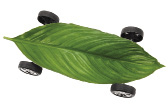
Latest News
March 1, 2015
 The shapes and configurations of nature are wildly complicated, often non-intuitive, yet completely amazing. The shapes and forms of a tree, a human skeleton, an insect or animal are the most efficient designs imaginable. To mimic the flawless balance between structure and strength of nature’s most efficient shapes, a Michigan based Engineering Consulting Company, Engineering Technology Associates (ETA), offers unique product design optimization services. These engineering solutions incorporate a similar balance to product structures in terms of shape, material and thickness for heavy-trucks, buses, automobiles, aircraft and a variety of other structural products.
The shapes and configurations of nature are wildly complicated, often non-intuitive, yet completely amazing. The shapes and forms of a tree, a human skeleton, an insect or animal are the most efficient designs imaginable. To mimic the flawless balance between structure and strength of nature’s most efficient shapes, a Michigan based Engineering Consulting Company, Engineering Technology Associates (ETA), offers unique product design optimization services. These engineering solutions incorporate a similar balance to product structures in terms of shape, material and thickness for heavy-trucks, buses, automobiles, aircraft and a variety of other structural products.
The Secret Recipe
 At the heart of this offering is a patented process that ETA’s Engineering Consulting Team developed and offers as a service to its client base worldwide. The Accelerated Concept to Product (ACP) Process® is a methodology which enables the structure of a product, such as the vehicle’s body-in-white, to mimic “Nature’s Way.” Doing so creates the ultimate design efficiency, where structure and strength are perfectly balanced for the intended function. The results of this service are higher performing products combined with significant mass reduction. Achievable optimization results include:
At the heart of this offering is a patented process that ETA’s Engineering Consulting Team developed and offers as a service to its client base worldwide. The Accelerated Concept to Product (ACP) Process® is a methodology which enables the structure of a product, such as the vehicle’s body-in-white, to mimic “Nature’s Way.” Doing so creates the ultimate design efficiency, where structure and strength are perfectly balanced for the intended function. The results of this service are higher performing products combined with significant mass reduction. Achievable optimization results include:
• Significantly Reduced Product Development Costs
• Significantly Reduced Product Mass (20% to 40%)
• Improved Product Performance (stiffness, durability, NVH, Impact and crash/safety)
• Increased Fuel Efficiency
Background on the ACP Optimization Process
 In June 2014, a US Patent was issued for ETA’s ACP Optimization Process, which is a performance-driven, holistic product design development method based on design optimization. It incorporates the use of multiple CAE and CAO tools in a systematic process to generate the optimal design solution. This methodology provides solutions, which address the challenges facing the modern product development environment. It achieves this by synchronizing the individual facets of the product development process, resulting in an overall reduction in development costs and time to market.
In June 2014, a US Patent was issued for ETA’s ACP Optimization Process, which is a performance-driven, holistic product design development method based on design optimization. It incorporates the use of multiple CAE and CAO tools in a systematic process to generate the optimal design solution. This methodology provides solutions, which address the challenges facing the modern product development environment. It achieves this by synchronizing the individual facets of the product development process, resulting in an overall reduction in development costs and time to market.
Many Industries
The transportation industry, and more specifically the automotive industry, is facing numerous challenges today. The product design and development process includes multi-dimensional issues, which often contradict each other. A central challenge is the need for cost reduction to compete in the global market while continuing to meet all new and existing requirements for quality and performance. The cost reduction objective is challenged by a few factors, including aggressive fuel economy and emissions standards. Other factors include new crash safety requirements, increasing customer demands and expectations for quality and performance and the availability of new energy sources such as electric/hybrid vehicles, plug-in technologies and fuel cells. These requirements indicate that new approaches are necessary.
The ACP Process Summary
 To most effectively explore the design space (design volume, material and manufacturing process), while trying to reduce design cycle times, ETA engineers use the ACP Process. It can be described as a “search engine” that does not “invent” designs; rather it searches the predefined available design space for the best possible solutions, which meet all of the design constraints. It evaluates hundreds of design concepts, finding a set of acceptable design solutions, which also contains the optimal, or near-optimal design solution.
To most effectively explore the design space (design volume, material and manufacturing process), while trying to reduce design cycle times, ETA engineers use the ACP Process. It can be described as a “search engine” that does not “invent” designs; rather it searches the predefined available design space for the best possible solutions, which meet all of the design constraints. It evaluates hundreds of design concepts, finding a set of acceptable design solutions, which also contains the optimal, or near-optimal design solution.
The holistic design process investigates the entire design space available and then defines the most robust design solution. The tools within ACP can greatly decrease the time required to identify a set of feasible, or even near-optimal, designs prior to building and testing the first prototype. Moreover, ACP can also compensate for the limitations of human intuition and provide design engineers with the freedom and power to seek creative solutions that are not always obvious to even the most experienced engineers.
The process analyzes multi-disciplinary loading, based on topology optimization and Geometry, Grade and Gauge (3G) Optimization. Using multiple CAE tools (modeling tools, application-specific tools, solver technology and optimization solutions) CAE, design and manufacturing are all synchronized. Once an optimal concept is identified, the ACP Process further generates the design, analyzes it and optimizes it using loading, manufacturing, material and cost constraints. It then outputs CAD data of an optimized concept design, suitable for detailed design and manufacturing.
The process can be applied to a wide variety of structural products and can be customized based on the client’s ultimate goals. ACP can be implemented as a weight reduction strategy for current product refinement, starting with a current product design the client wishes to improve upon. Alternatively, it can be applied to a clean sheet design in order to develop a brand new product.
To learn more go to: www.eta.com
This article was sponsored byEngineering Technology Associates (ETA).
Subscribe to our FREE magazine, FREE email newsletters or both!
Latest News
About the Author
DE’s editors contribute news and new product announcements to Digital Engineering.
Press releases may be sent to them via [email protected].






